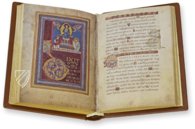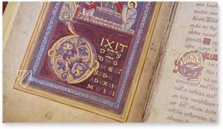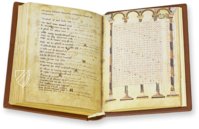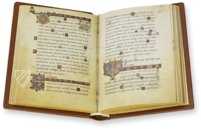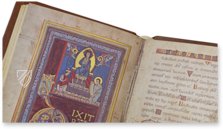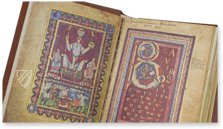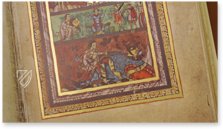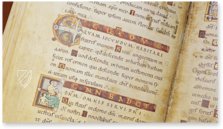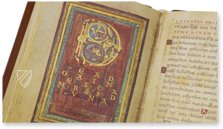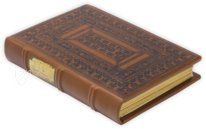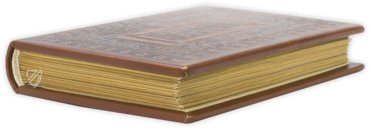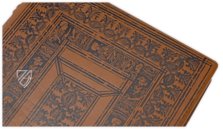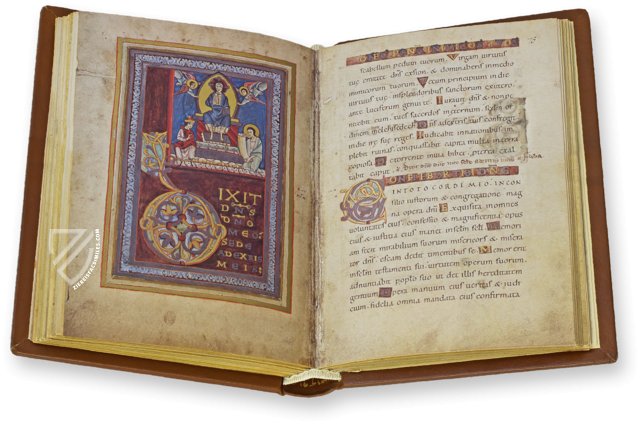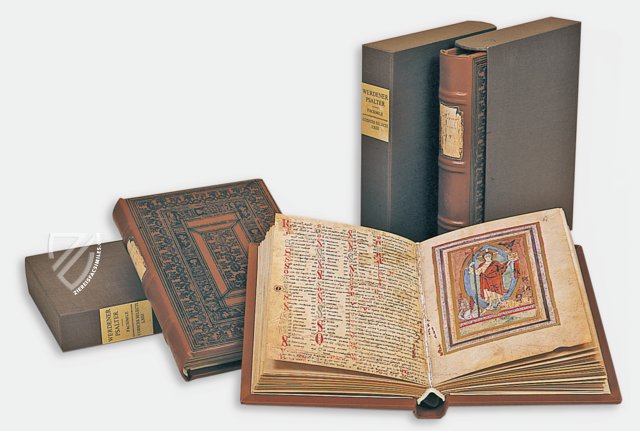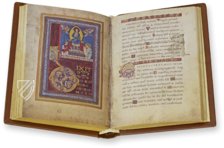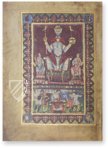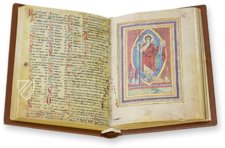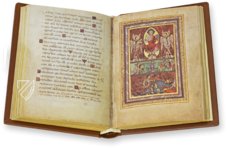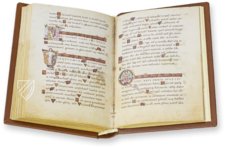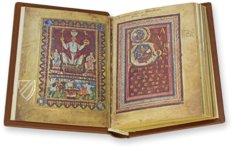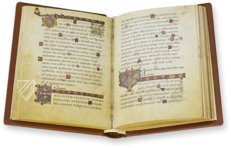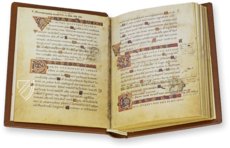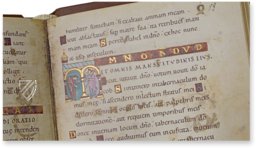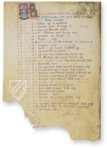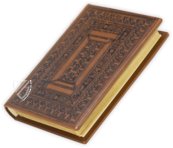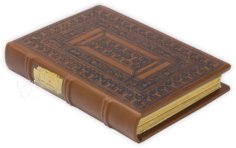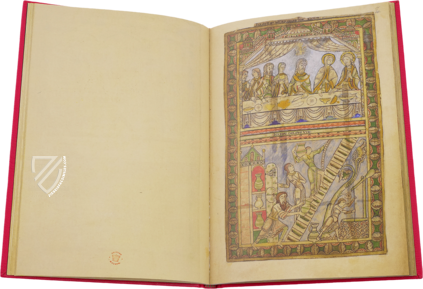Werden Psalter
(1,000€ - 3,000€)
Werden Abbey on the Ruhr River was founded ca. 800 by St. Liudger. It flourished during the 11th century and acquired a self-confidence to which the splendor of the Werden Psalter bears fascinating witness: it was never intended for liturgical use but was intended for a rich and highly placed personality. The author's picture shows David in his double function as the overpowering King of Israel and as the sensitive author of the Psalms. The play of delightful contrasts pervades this high point of 11th century illumination. The dignified seriousness, which is also expressed by the elegant late Carolingian minuscule, is in creative tension with the fanciful initial ornamentation. There are wonderful initials and Romanesque miniatures of the highest artistry before each of the 150 Psalms. Thus, this splendid Psalter is an important link between the late Carolingian and Romanesque styles.
Werden Psalter
The Werden Psalter belongs to the most significant and widely known deluxe medieval manuscripts kept in the Staatsbibliothek Preussischer Kulturbesitz of Berlin. It is also called the “Luxury Psalter” because of its lavish decoration and bears splendid testimony to medieval illumination. The codex was made at Werden where Saint Liudger, Bishop of Münster, had founded an abbey around the year 800. This Benedictine abbey had its heyday in the 11th century and the Werden Psalter may be looked upon as the artistic expression of a proud monastery. The manuscript contains a psalter in an unusual form of text. The contents and artistic decoration of the Werden Psalter are extremely rich and remarkable in all aspects. Its outstanding miniatures, which have always been an object of admiration, its marvelous initials of great artistic importance with respect to illumination, the ornamental pages and titles, as well as the script are all important features of this unrivalled and perfectly harmonious work.
The Extravagant Splendor of a Sumptuous Psalter
The series of psalms contained in the book is preceded by the author’s portrait depicting the biblical King David in his two functions, as sovereign and as a composer of the Psalms (fol. 1v). This topic returns in two further episodes with the slaying of Goliath on fol. 74r and the presentation of his head to King Saul. The third full-page miniature shows Christ having won the fight against the dragon and the lion (fol. 64r). The strictly formal, symmetrical structure and balanced coloring of the title illustrations convey a feeling of peace and dignified sobriety, thus forming a charming contrast to the elaborate ornamental decoration of initials.
Gold and Silver Initials
The initial pages following the miniature pages introduce each subsequent Psalm with gold and silver tendrils, initials set against a purple background, as well as gold and silver initials. Furthermore, all 150 psalms as well as the subsequent cantica start with large initials composed of gold and silver tendrils. They are complete with particularly elaborate ornamental lines on a purple field with alternating gold and silver majuscules. The text is written without paragraphs in an even, elegant late Carolingian minuscule script; the verse incipits are marked with small purple squares containing gold and silver letters. A total of 190 interlaced initials consist of geometrically arranged bands, many of them enriched with floral elements. Architecture, dragons, birds, dogs, and depictions of humans embellish the bands in the ornamental letters, making them resourceful miniatures in their own right. They all lend the work an overall impression of invaluable luxury, which only a few other manuscripts may boast.
Text and Calendar
The Werden Psalter contains the text of the Psalterium Romanum**, an old Latin text which hardly differs from the Vulgate version, as well as related old Latin cantica and several prayers. The manuscript concludes with a comprehensive calendar and two calculation tables for the feast of Easter and the moon dates required for this purpose. The *Werden Psalter is no doubt a luxury psalter that was produced for a high-ranking and wealthy individual rather than serving liturgical purposes. Both the text and decorative apparatus of the book support this assumption.
The Binding
The manuscript is protected by a lavishly ornate leather binding which is not the original but was made in the second half of the 16th century. It was decorated using roulettes, i.e. metal rolls which were heated up before rolling them onto the humid leather. In a frame appear the inscribed busts of Fortitudo (Courage), Prudentia (Prudence), and Iustitia (Justice), as well as a fourth virtue Lucrecia, instead of Temperantia (Moderation) as one would expect.
Codicology
- Alternative Titles
- Werdener Psalter
- Size / Format
- 237 pages / 25.4 × 17.5 cm
- Origin
- Germany
- Date
- After 1029
- Style
- Genre
- Language
- Illustrations
- 6 full-page miniatures and ornaments, 190 larger mostly golden and silver initial letters
Werden Psalter
Incipit Page: Beatus Vir
This “B” initial is a fine specimen of Romanesque art and introduces the phrase Beatus vir or “Blessed is the man”, which are the opening words of the Book of Psalms in Latin. Only the finest materials were used for the creation of this incipit page: rich pigments, gold leaf, and a purple dyed background. The black lettering is actually silver that has oxidized over the centuries. King David, the author of the Psalms, is depicted working in both registers of this fine historiated initial.
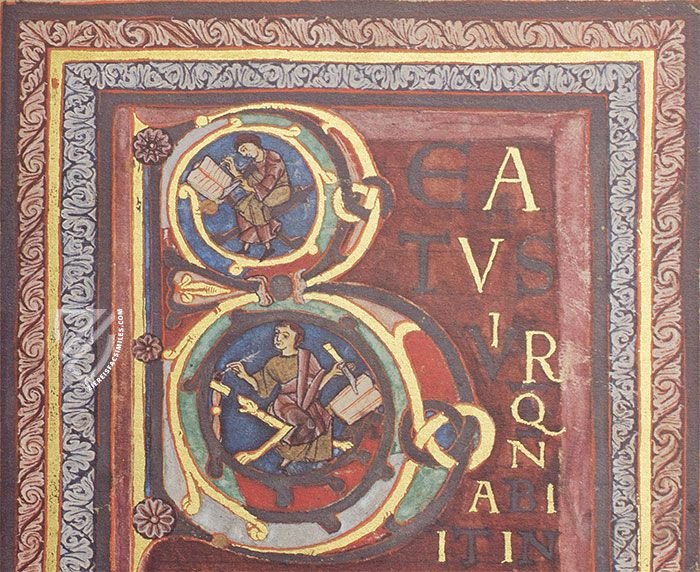
Werden Psalter
Portrait of King David
The opening page of this perfectly harmonious work of Romanesque illumination depicts the reputed author of the Psalms, King David. He is depicted in his two functions in this miniature, which is split into two registers: above we see David the ruler of the Kingdom of Israel, below we see him as the composer of the Psalms.
Like the rest of the miniatures in the manuscript, this composition is distinguished by its symmetrical structure, balanced color palette, and its overall sense of peace and dignified sobriety. The rich colors, purple in particular, contrast wonderfully with the gold leaf of the frame and highlights the scene’s imagery. Entertainers ranging from musicians to jugglers are depicted in small medallions at the frame’s corners.
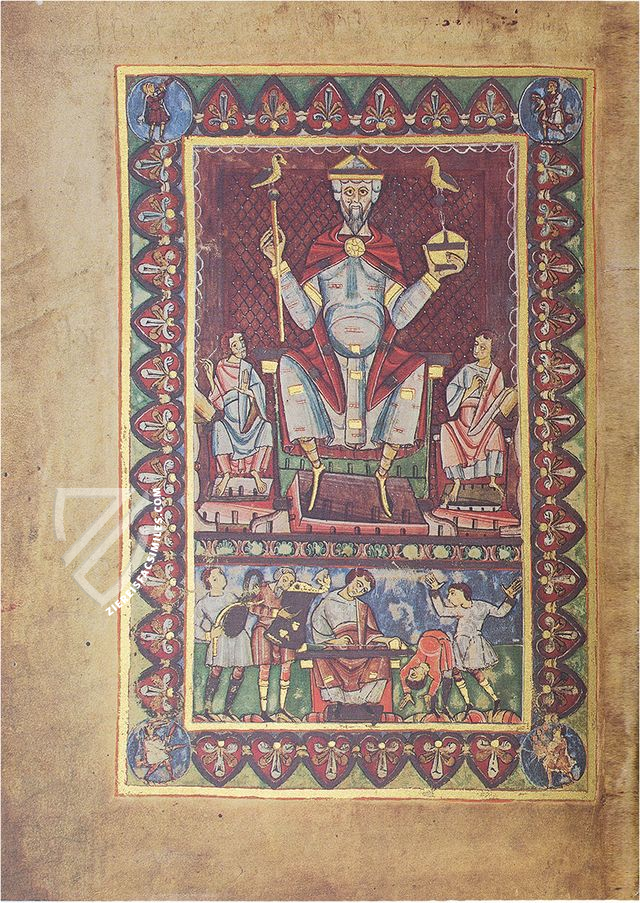
#1 Der Werdener Psalter (Standard Edition)
Language: German
The scholarly commentary by Hermann Knaus provides a comprehensive description of the Werden Psalter. It not only discusses the art historical significance of its miniatures and decoration but also explains the contents of the work and analyses the dating and localisation of the manuscript.
(1,000€ - 3,000€)
#2 Der Werdener Psalter (De Luxe Edition)
Language: German
The scholarly commentary by Hermann Knaus provides a comprehensive description of the Werden Psalter. It not only discusses the art historical significance of its miniatures and decoration but also explains the contents of the work and analyses the dating and localisation of the manuscript.
(1,000€ - 3,000€)
- Treatises / Secular Books
- Apocalypses / Beatus
- Astronomy / Astrology
- Bestiaries
- Bibles / Gospels
- Chronicles / History / Law
- Geography / Maps
- Saints' Lives
- Islam / Oriental
- Judaism / Hebrew
- Single Leaf Collections
- Leonardo da Vinci
- Literature / Poetry
- Liturgical Manuscripts
- Medicine / Botany / Alchemy
- Music
- Mythology / Prophecies
- Psalters
- Other Religious Books
- Games / Hunting
- Private Devotion Books
- Other Genres
- Afghanistan
- Armenia
- Austria
- Belgium
- Belize
- Bosnia and Herzegovina
- China
- Colombia
- Costa Rica
- Croatia
- Cyprus
- Czech Republic
- Denmark
- Egypt
- El Salvador
- Ethiopia
- France
- Germany
- Greece
- Guatemala
- Honduras
- Hungary
- India
- Iran
- Iraq
- Israel
- Italy
- Japan
- Jordan
- Kazakhstan
- Kyrgyzstan
- Lebanon
- Liechtenstein
- Luxembourg
- Mexico
- Morocco
- Netherlands
- Palestine
- Panama
- Peru
- Poland
- Portugal
- Romania
- Russia
- Serbia
- Spain
- Sri Lanka
- Sweden
- Switzerland
- Syria
- Tajikistan
- Turkey
- Turkmenistan
- Ukraine
- United Kingdom
- United States
- Uzbekistan
- Vatican City
- A. Oosthoek, van Holkema & Warendorf
- Aboca Museum
- Ajuntament de Valencia
- Akademie Verlag
- Akademische Druck- u. Verlagsanstalt (ADEVA)
- Aldo Ausilio Editore - Bottega d’Erasmo
- Alecto Historical Editions
- Alkuin Verlag
- Almqvist & Wiksell
- Amilcare Pizzi
- Andreas & Andreas Verlagsbuchhandlung
- Archa 90
- Archiv Verlag
- Archivi Edizioni
- Arnold Verlag
- ARS
- Ars Magna
- ArtCodex
- AyN Ediciones
- Azimuth Editions
- Badenia Verlag
- Bärenreiter-Verlag
- Belser Verlag
- Belser Verlag / WK Wertkontor
- Benziger Verlag
- Bernardinum Wydawnictwo
- BiblioGemma
- Biblioteca Apostolica Vaticana (Vaticanstadt, Vaticanstadt)
- Bibliotheca Palatina Faksimile Verlag
- Bibliotheca Rara
- Boydell & Brewer
- Bramante Edizioni
- Bredius Genootschap
- Brepols Publishers
- British Library
- C. Weckesser
- Caixa Catalunya
- Canesi
- CAPSA, Ars Scriptoria
- Caratzas Brothers, Publishers
- Carus Verlag
- Casamassima Libri
- Centrum Cartographie Verlag GmbH
- Chavane Verlag
- Christian Brandstätter Verlag
- Circulo Cientifico
- Club Bibliófilo Versol
- Club du Livre
- CM Editores
- Collegium Graphicum
- Collezione Apocrifa Da Vinci
- Comissão Nacional para as Comemorações dos Descobrimentos Portugueses
- Coron Verlag
- Corvina
- CTHS
- D. S. Brewer
- Damon
- De Agostini/UTET
- De Nederlandsche Boekhandel
- De Schutter
- Deuschle & Stemmle
- Deutscher Verlag für Kunstwissenschaft
- DIAMM
- Droz
- E. Schreiber Graphische Kunstanstalten
- Ediciones Boreal
- Ediciones Grial
- Ediclube
- Edições Inapa
- Edilan
- Editalia
- Edition Deuschle
- Edition Georg Popp
- Edition Leipzig
- Edition Libri Illustri
- Editiones Reales Sitios S. L.
- Éditions de l'Oiseau Lyre
- Editions Medicina Rara
- Editorial Casariego
- Editorial Mintzoa
- Editrice Antenore
- Editrice Velar
- Edizioni Edison
- Egeria, S.L.
- Eikon Editores
- Electa
- Emery Walker Limited
- Enciclopèdia Catalana
- Eos-Verlag
- Ephesus Publishing
- Ernst Battenberg
- Eugrammia Press
- Extraordinary Editions
- Fackelverlag
- Facsimila Art & Edition
- Facsimile Editions Ltd.
- Facsimilia Art & Edition Ebert KG
- Faksimile Verlag
- Feuermann Verlag
- Folger Shakespeare Library
- Franco Cosimo Panini Editore
- Friedrich Wittig Verlag
- Fundación Hullera Vasco-Leonesa
- G. Braziller
- Gabriele Mazzotta Editore
- Gebr. Mann Verlag
- Gesellschaft für graphische Industrie
- Getty Research Institute
- Giovanni Domenico de Rossi
- Giunti Editore
- Graffiti
- Grafica European Center of Fine Arts
- Guido Pressler
- Guillermo Blazquez
- Gustav Kiepenheuer
- H. N. Abrams
- Harrassowitz
- Harvard University Press
- Helikon
- Hendrickson Publishers
- Henning Oppermann
- Herder Verlag
- Hes & De Graaf Publishers
- Hoepli
- Holbein-Verlag
- Houghton Library
- Hugo Schmidt Verlag
- Idion Verlag
- Il Bulino, edizioni d'arte
- ILte
- Imago
- Insel Verlag
- Insel-Verlag Anton Kippenberger
- Instituto de Estudios Altoaragoneses
- Instituto Nacional de Antropología e Historia
- Introligatornia Budnik Jerzy
- Istituto dell'Enciclopedia Italiana - Treccani
- Istituto Ellenico di Studi Bizantini e Postbizantini
- Istituto Geografico De Agostini
- Istituto Poligrafico e Zecca dello Stato
- Italarte Art Establishments
- Jan Thorbecke Verlag
- Johnson Reprint Corporation
- Josef Stocker
- Josef Stocker-Schmid
- Jugoslavija
- Karl W. Hiersemann
- Kasper Straube
- Kaydeda Ediciones
- Kindler Verlag / Coron Verlag
- Kodansha International Ltd.
- Konrad Kölbl Verlag
- Kurt Wolff Verlag
- La Liberia dello Stato
- La Linea Editrice
- La Meta Editore
- Lambert Schneider
- Landeskreditbank Baden-Württemberg
- Leo S. Olschki
- Les Incunables
- Liber Artis
- Library of Congress
- Libreria Musicale Italiana
- Lichtdruck
- Lito Immagine Editore
- Lumen Artis
- Lund Humphries
- M. Moleiro Editor
- Maison des Sciences de l'homme et de la société de Poitiers
- Manuscriptum
- Martinus Nijhoff
- Maruzen-Yushodo Co. Ltd.
- MASA
- Massada Publishers
- McGraw-Hill
- Metropolitan Museum of Art
- Militos
- Millennium Liber
- Müller & Schindler
- Nahar - Stavit
- Nahar and Steimatzky
- National Library of Wales
- Neri Pozza
- Nova Charta
- Oceanum Verlag
- Odeon
- Orbis Mediaevalis
- Orbis Pictus
- Österreichische Staatsdruckerei
- Oxford University Press
- Pageant Books
- Parzellers Buchverlag
- Patrimonio Ediciones
- Pattloch Verlag
- PIAF
- Pieper Verlag
- Plon-Nourrit et cie
- Poligrafiche Bolis
- Presses Universitaires de Strasbourg
- Prestel Verlag
- Princeton University Press
- Prisma Verlag
- Priuli & Verlucca, editori
- Pro Sport Verlag
- Propyläen Verlag
- Pytheas Books
- Quaternio Verlag Luzern
- Reales Sitios
- Recht-Verlag
- Reichert Verlag
- Reichsdruckerei
- Reprint Verlag
- Riehn & Reusch
- Roberto Vattori Editore
- Rosenkilde and Bagger
- Roxburghe Club
- Salerno Editrice
- Saltellus Press
- Sandoz
- Sarajevo Svjetlost
- Schöck ArtPrint Kft.
- Schulsinger Brothers
- Scolar Press
- Scrinium
- Scripta Maneant
- Scriptorium
- Shazar
- Siloé, arte y bibliofilia
- SISMEL - Edizioni del Galluzzo
- Sociedad Mexicana de Antropología
- Société des Bibliophiles & Iconophiles de Belgique
- Soncin Publishing
- Sorli Ediciones
- Stainer and Bell
- Studer
- Styria Verlag
- Sumptibus Pragopress
- Szegedi Tudomànyegyetem
- Taberna Libraria
- Tarshish Books
- Taschen
- Tempus Libri
- Testimonio Compañía Editorial
- Thames and Hudson
- The Clear Vue Publishing Partnership Limited
- The Facsimile Codex
- The Folio Society
- The Marquess of Normanby
- The Richard III and Yorkist History Trust
- Tip.Le.Co
- TouchArt
- TREC Publishing House
- TRI Publishing Co.
- Trident Editore
- Tuliba Collection
- Typis Regiae Officinae Polygraphicae
- Union Verlag Berlin
- Universidad de Granada
- University of California Press
- University of Chicago Press
- Urs Graf
- Vallecchi
- Van Wijnen
- VCH, Acta Humaniora
- VDI Verlag
- VEB Deutscher Verlag für Musik
- Verlag Anton Pustet / Andreas Verlag
- Verlag Bibliophile Drucke Josef Stocker
- Verlag der Münchner Drucke
- Verlag für Regionalgeschichte
- Verlag Styria
- Vicent Garcia Editores
- W. Turnowski Ltd.
- W. Turnowsky
- Waanders Printers
- Wiener Mechitharisten-Congregation (Wien, Österreich)
- Wissenschaftliche Buchgesellschaft
- Wissenschaftliche Verlagsgesellschaft
- Wydawnictwo Dolnoslaskie
- Xuntanza Editorial
- Zakład Narodowy
- Zollikofer AG




